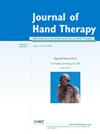运动恐惧症、灾难化和固定时间:腕-手损伤后肩部残疾相关因素的前瞻性研究。
IF 1.8
4区 医学
Q2 ORTHOPEDICS
引用次数: 0
摘要
背景:肩关节疼痛是腕-手固定后的主要肌肉骨骼问题。关于运动恐惧症或疼痛灾难与腕-手损伤后肩部疼痛和残疾的关系的证据有限。目的:探讨腕-手损伤患者6个月后运动恐惧与同侧持续性肩部残疾的疼痛灾难的关系。研究设计:前瞻性研究。方法:招募年龄≥18岁的腕-手损伤后需要腕-手固定治疗的参与者,并在基线、固定期后和6个月后完成数字疼痛量表、肩部疼痛和残疾指数、疼痛巨化量表(PCS)和运动恐惧症坦帕量表(TSK)。结果:共纳入107例患者。舟状骨骨折49例(45.8%),桡骨远端骨折58例(54.2%)。固定时间每增加一周,肩部疼痛和残疾指数得分增加10.2分,95%置信区间(CI)[6.76, 13.57],较高的固定水平与肩部疼痛和残疾增加有关。基线TSK评分为17.4,随访时为11.2。PCS评分最初为14.8分,随访时降至9.3分。在预测模型中加入TSK和PCS后,R2为0.163,F(2100) = 47.471, p具有统计学意义。结论:损伤后腕关节固定时间可能对损伤后6个月肩关节残疾水平起关键作用。这种肩部残疾可能受到诸如害怕运动等因素的影响。本文章由计算机程序翻译,如有差异,请以英文原文为准。
Kinesiophobia, catastrophizing, and the duration of immobilization: A prospective study on factors associated with shoulder disability following wrist-hand injuries
Background
Shoulder pain is a major musculoskeletal problem after wrist-hand immobilization. There is limited evidence regarding the relationship of kinesiophobia or pain catastrophizing with shoulder pain and disability after wrist-hand injury.
Purpose
To explore associations between kinesiophobia and pain catastrophizing with ipsilateral persistent shoulder disability in patients with wrist-hand injury after 6 months.
Study Design
Prospective study.
Methods
Participants aged ≥18 years referred to hand therapy after wrist-hand injury requiring wrist-hand immobilization were recruited and completed the Numeric Pain Scale, Shoulder Pain and Disability Index, Pain Catastrophizing Scale (PCS), and Tampa scale for kinesiophobia (TSK) at baseline, after an immobilization period, and after 6 months.
Results
A total of 107 patients were included in the study. Scaphoid fractures were found in 49 (45.8%) of patients, and 58 (54.2%) had distal radius fractures. For each week of increased time spent in immobilization, the Shoulder Pain and Disability Index score increased by 10.2 points, 95% confidence interval (CI) [6.76, 13.57], with higher levels of immobilization being associated with increased shoulder pain and disability. The baseline TSK score was 17.4 and 11.2 at follow-up. The PCS score was initially 14.8 and decreased to 9.3 at follow-up. The addition of TSK and PCS to the predictive model led to a statistically significant increase in R2 of 0.163, F(2,100) = 47.471, p < 0.001.
Conclusions
The duration of wrist immobilization following an injury may play a crucial role in the level of shoulder disability experienced at the 6-month mark post-injury. This shoulder disability may be influenced by factors such as fear of movement.
求助全文
通过发布文献求助,成功后即可免费获取论文全文。
去求助
来源期刊

Journal of Hand Therapy
医学-外科
CiteScore
3.50
自引率
10.00%
发文量
65
审稿时长
19.2 weeks
期刊介绍:
The Journal of Hand Therapy is designed for hand therapists, occupational and physical therapists, and other hand specialists involved in the rehabilitation of disabling hand problems. The Journal functions as a source of education and information by publishing scientific and clinical articles. Regular features include original reports, clinical reviews, case studies, editorials, and book reviews.
 求助内容:
求助内容: 应助结果提醒方式:
应助结果提醒方式:


